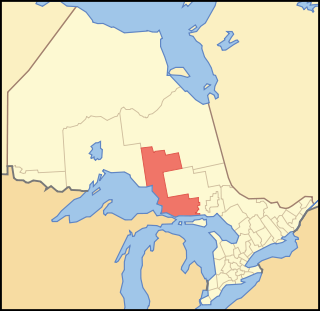
Algoma District is a district and census division in Northeastern Ontario in the Canadian province of Ontario.
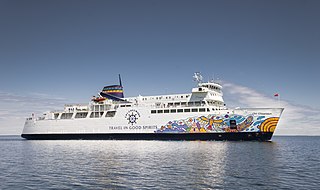
MS Chi-Cheemaun is a Canadian passenger and vehicle ferry in Ontario, Canada, which traverses Lake Huron between Tobermory on the Bruce Peninsula and South Baymouth on Manitoulin Island. The ferry connects the two geographically separate portions of Highway 6 and is the vessel that replaced MS Norgoma and SS Norisle in 1974. The ferry service runs seasonally from mid-May to mid-October. As of 2022 she is the third largest passenger vessel sailing the Great Lakes after the expedition cruise liner Viking Octantis and the US ferry SS Badger, although several larger vessels previously serving the Great Lakes are still in service in other parts of the world.

Wawa is a township in the Canadian province of Ontario in the Algoma District. Formerly known as the Township of Michipicoten, named after a nearby river of that name, the township was officially renamed in 2007 for its largest and best-known community of Wawa, located on the western shores of Wawa Lake.
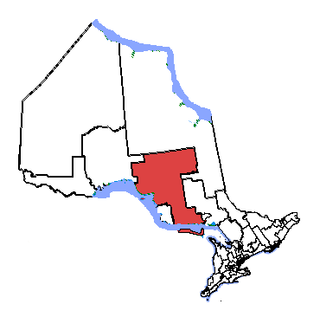
Algoma—Manitoulin—Kapuskasing is a federal electoral district in Ontario, Canada, that has been represented in the House of Commons of Canada since 2004. The area was represented by the riding of Algoma from 1867 to 1904 and from 1968 to 1996 and then by Algoma—Manitoulin from 1996 to 2004.
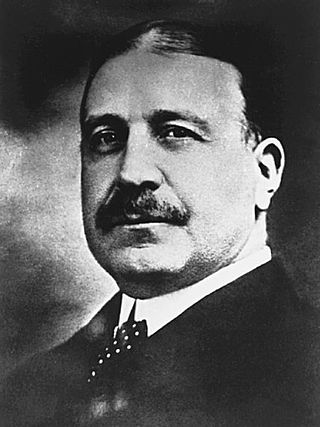
Francis Hector Clergue was an American businessman who became the leading industrialist of Sault Ste. Marie, Ontario, Canada, at the turn of the 20th century.
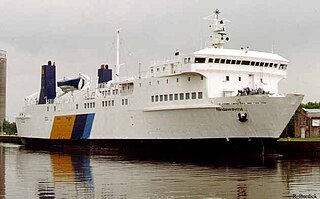
The MV Manx Viking / Nindawayma was a passenger, truck and car ferry, whose last active service was on Lake Huron, operated by the Owen Sound Transportation Company; under contract to the Ontario Ministry of Transportation. In Canadian service she served the Highway 6 route between Tobermory and South Baymouth, Manitoulin Island from 1989 to 1992 alongside the MS Chi-Cheemaun.

The Huron Central Railway is a railway operating in northern Ontario, Canada. It is operated by Genesee & Wyoming Canada, the Canadian subsidiary of Genesee & Wyoming.

Cockburn Island is an island and township municipality in the Canadian province of Ontario, located in the Manitoulin District. It is separated from the westernmost point of Manitoulin Island by the Mississagi Strait, and from Michigan's Drummond Island by the False Detour Channel. The island is incorporated as and coterminous with the municipal Township of Cockburn Island.

The Owen Sound Transportation Company Limited is a Crown agency of the Government of Ontario responsible for operating seasonal ferry services within Ontario. The agency is based in Owen Sound and was established in 1921 as a private company until it was fully acquired by the Government of Ontario in 1973. The agency operates the M.S. Chi-Cheemaun between Tobermory and South Baymouth; the M.V. Niska I between Moosonee and Moose Factory Island; and the M.V. Pelee Islander, M.V. Pelee Islander II, and M.V. Jiimaan between Kingsville/Leamington and Pelee Island. The M.V. Pelee Islander is also operated between Pelee Island and Sandusky, Ohio.

SS Norisle was a Canadian steam-powered automobile ferry that operated between Tobermory and South-Baymouth Manitoulin Island alongside her sister ships, the MS Norgoma and the MS Normac, owned by the Owen Sound Transportation Company Limited.

Normac is a floating restaurant boat that was launched as a fire tug, named the James R. Elliot. She was built at the Jenks Shipbuilding Company in Port Huron, Michigan, in 1902.

SS Valley Camp is a lake freighter that served on the Great Lakes for almost 50 years and is now a museum ship in Sault Ste. Marie, Michigan.

Sault Ste. Marie Transit Services is a local public transportation service serving the city of Sault Ste. Marie, Ontario providing seven major bus routes and two community bus routes serviced by a fleet of 27 buses and 2 minibuses. The Parabus service consists of 11 vehicles.
The Diocese of Algoma is a diocese of the Ecclesiastical Province of Ontario of the Anglican Church of Canada. It comprises nearly 182,000 square kilometres of the Ontario districts of Algoma, Thunder Bay, Sudbury, Manitoulin, and parts of the districts of Nipissing and Timiskaming. The diocese forms a wide band stretching from just west of Thunder Bay on the northern shore of Lake Superior east to the border of Ontario and Quebec. Neighbouring Anglican dioceses are Rupert's Land to the west, Moosonee to the north, Ottawa to the east, and Ontario, Toronto, Huron to the south.

Sault Ste. Marie is a city in Ontario, Canada. The third-largest city in Northern Ontario after Sudbury and Thunder Bay, it is located on the St. Mary's River on the Canada–US border. To the southwest, across the river, is the United States and the city of Sault Ste. Marie, Michigan. The two cities are joined by the Sault Ste. Marie International Bridge, which connects Interstate 75 on the Michigan side to Huron Street on the Ontario side. Shipping traffic in the Great Lakes system bypasses the Saint Mary's Rapids via the American Soo Locks, the world's busiest canal in terms of tonnage that passes through it, while smaller recreational and tour boats use the Canadian Sault Ste. Marie Canal.
The Algoma Eastern Railway was a railway in Northeastern Ontario, Canada. Originally known as the Manitoulin and North Shore Railway (M&NS) with a charter dating back to 1888, the full mainline was opened to traffic in 1913, serving the area along the north shore of Lake Huron between Sudbury and Little Current on Manitoulin Island. It and its sister railway, the Algoma Central, were originally owned by the Lake Superior Corporation, a conglomerate centered on Sault Ste. Marie which was founded by the American industrialist Francis Clergue. Despite ambitious plans to expand across Lake Huron to the Bruce Peninsula using a railcar ferry, the company failed to develop further and was acquired by the Canadian Pacific Railway in 1930. With freight traffic low during the Great Depression, Canadian Pacific soon abandoned much of the Algoma Eastern mainline in favor of its own Algoma Branch. Remaining sections of the Algoma Eastern line were turned into spurs, with the longest surviving section operated as a branch line known as the Little Current Subdivision.

Due to its unique geography, being made of two peninsulas surrounded by the Great Lakes, Michigan has depended on many ferries for connections to transport people, vehicles and trade. The most famous modern ferries are those which carry people and goods across the Straits of Mackinac to the car-free Mackinac Island but before the Mackinac Bridge was built, large numbers of ferries carried people and cars between the two peninsulas. Other ferries continue to provide transportation to small islands and across the Detroit River to Canada. Ferries once provided transport to island parks for city dwellers. The state's only national park, Isle Royale cannot be reached by road and is normally accessed by ferry. The largest ferries in Michigan are the car ferries which cross Lake Michigan to Wisconsin. One of these, the SS Badger is one of the last remaining coal steamers on the Great Lakes and serves as a section of US Highway 10 (US 10). The Badger is also the largest ferry in Michigan, capable of carrying 600 passengers and 180 autos.

Agawa Canyon station is a railway station at the railway point of Canyon, in the Unorganized North part of Algoma District in Ontario, Canada. It lies on the Algoma Central Railway (ACR) main line, between Frater to the south and Eton to the north, and is acts as the terminus for the Agawa Canyon Tour Train. The Algoma Central Railway is a subsidiary of Canadian National Railway. The railway provides the option of renting a Canyon Camp Car that has been refurbished for this purpose.
Algoma Sault, which entered service in 2018, is the third freighter Algoma Central named after Sault Ste. Marie, Ontario. She is a self-unloading bulk carrier, built for carrying cargoes like ore, grain, or coal, on the North American Great Lakes and St. Lawrence Seaway. She is the seventh vessel of the Equinox class, and like her sister ships she was built in China.

















